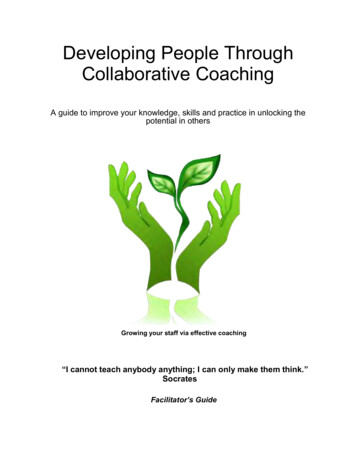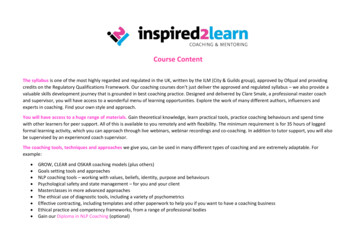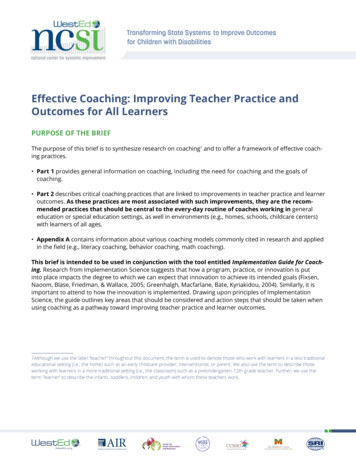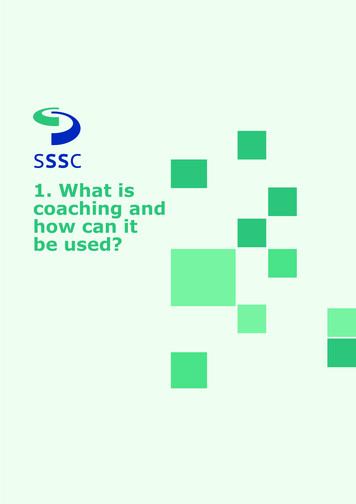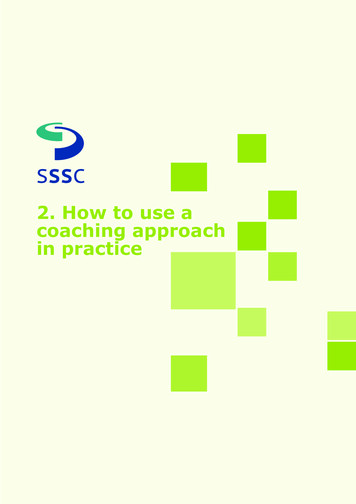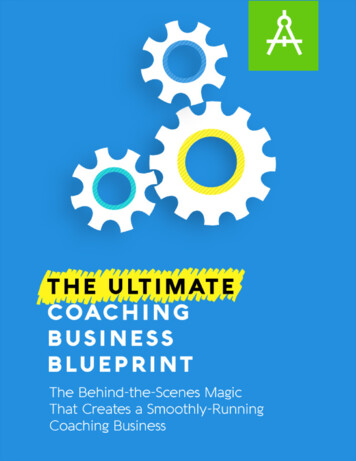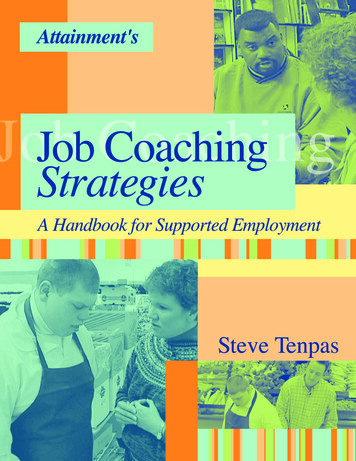
Transcription
Steve Tenpas, AuthorBarb Smith, Tom Kinney, EditorsJennifer Conn, Graphic DesignAn Attainment Company Publication 2003 Attainment Company, Inc. All rights reserved.Printed in the United States of AmericaISBN 1-57861-160-1Job Coaching Strategies is also available as aVHS and DVD product, produced by Video Architects, L.L.C.and Attainment Company, Inc.AAttainment Company, Inc.P.O. Box 930160 Verona, Wisconsin 53593-0160Phone: 800-327-4269 Fax: 800.942.3865www.AttainmentCompany.comReproducible resources within this material may bephotocopied for personal and educational use.
Tableofof ContentsContentsTable5Forward7About the Author9Introduction11Getting to Know Your Clientthe functional assessment25Finding a Good Matchthe supported employment assessment33Case Studiesfunctional assessment & supported employment activities57Work Site Analysisthe ecological inventory67Training Strategiestechniques, 67job task planning, 77job task support plan, 93fading from the job site, 101105Putting it All Togetherproblem solving, 105employer relations, 111113Facilitator’s Guide115Activity Keys123Reproducible Forms129Resources and Acknowledgements131IndexTable of Contents3
ForwardForwardThe supported employment profession has been changing, growingand evolving along with the role of the Job Coach/Trainer. Our role inthe lives of individuals with disabilities is specific to the needs of eachperson and their employer. This requires basic tools and knowledge to providesuccessful support for those in community jobs. This manual begins thelearning process by providing the needed information to be a great job coach.Our support services directly impact the successful integration of persons with disabilitiesinto the work world. The difference we make with each person is measured by jobsatisfaction, pride in earning a paycheck, social opportunities that are opened to eachindividual, contributions made to the business, added income that results in consumerism,the impact on each place of employment as coworker lives are enriched and pride felt inbeing a part of the community in which you live!These materials help you feel connected to our profession, learn best practices insupported employment, new teaching techniques, and how to develop successful andindividualized approaches that work with people with disabilities and their employers.Our profession has many challenges, but it also has outcomes that benefit the individual,the employer, coworkers, taxpayers and the community. Make use of these materials as youchallenge yourself to find the best job match with quality job supports that results in asuccessful placement. The goal is job satisfaction for the person you are supporting andfor yourself!Janet EstervigExecutive Director of Work Opportunity in Rural Communities, Inc. (WORC)Bachelor of Science in Education (BSE) in Special EducationMaster of Science (MS) in Behavioral Disabilities—Vocational Rehabilitation CounselingForward5
IntroductionIntroductionThis manual is designed to teach the basic principles of job coaching.Used in conjunction with the video program “Job Coaching Strategies,”it explores the methods and practicalities of job coaching.The video features Nick, a 23 year old man who, with the support of jobcoaches, holds three jobs in his community. Read about Nick below andthroughout the book. Joining Nick in our instruction are six supportedemployees; Lori, Jay, Tyler, Mike, Beth and Marissa. You can also follow theirprogress throughout the book.Go through the manual in chronological order and complete the activitiesprovided. They are designed to help you practice some job coachingtechniques. Reproducible forms are provided in the back of the manual. Usethem as provided or alter them to fit your needs. Once you begin work as ajob coach, you will find this manual a helpful resource. The index in the backwill help you find specific information within the book.For a completedescription on usingthis manual withthe accompanyingVHS/DVD, see theFacilitator’s Guideon page 113.Nickick is a friendly and outgoing 23-year-old man.He stays active with work, family and communityactivities. He lives in his own home and has three jobs.NNick was born and raised in Wisconsin where heattended public school through high school. While inschool, Nick received instruction in community activitiessuch as using public transportation, shopping andordering food at restaurants. He also received vocationaltraining in community work sites. They includedjanitorial tasks at a private high school and stockingproduce at Copps food center where he currently works.Introduction9
After high school graduation, Nick kept his job at the grocery store and added twomore jobs, University Bookstore and The Frugal Muse bookstore where he shelvesbooks. Advanced Employment, a supported employment agency, works with him.Nick has contact with a wide network of family and friends. His family includes fatherDave and mother Jenny, brother Michael who is away at college, sisters Cori (age 17)and Katherine (age 14). Nick visits with his grandparents regularly and enjoys brunchon Sunday with his Grandmother. He also has close contact with his aunts, uncles andcousins who live in the area. Nick has many friends at work and they frequently eatlunch together and enjoy talking sports. On occasions, he meets one of them outsideof work to attend a hockey or football game. Nick maintains contact with formerclassmates, and they occasionally go out to eat or to a movie together.Nick is a tall man with a big smile. He walks with alimp as a result of paralysis of the right side of hisbody. He has limited use of his right arm and handbut compensates well with his strong left arm.Nick has limited vision that requires him to moveslowly in unfamiliar environments. Nick has RightHemiplegics Cerebral Palsy and MentalRetardation. He enjoys interacting with peoplearound him and uses a variety of methods tocommunicate. Nick’s speech is difficult tounderstand if you are unfamiliar with him or areunsure of the topic. He uses facial gestures andpointing to facilitate his communication.Nick does well with familiar and routine activities.At work he is most successful stocking, once it isset up for him. He can also complete the punch-inand punch-out routine independently. At home,Nick regularly participates in cleaning and mealpreparation. In general, he is cheerful. During timesof high frustration he may become upset and bitehis hand. This is infrequent and usually the result ofhaving to deal with unfamiliar staff.Editor's note: While Nick is an actual worker, whose picture appears throughout this manual, theother six "employees" profiled (starting on pg.29) are fictional composites; no real names are usedand the photos are not those of the people in the stories.10Introduction
GettingtotoKnowKnow YYourour ClientGettingClientthe functional assessmentKnowing your supported employee is a vital first step in a successfulrelationship. A functional assessment helps you focus on theindividual. It gives an overview of her strengths, support needs,interests, aptitudes, future goals and a historical perspective. Follow thefunctional assessment with a supported employment assessment, focusing onmore specific questions to develop a support plan. The combination of thefunctional and supported employment assessments give you the informationyou need to find the best possible job match for each individual you support.A successful functional assessment includes interviews or conversations with the peoplewho know each supported employee best. It’s helpful to interview the employee’s familymembers, especially his parents. Consider talking with teachers and current employers for awell rounded understanding of her needs and abilities.In this chapter, you will learn about: Areas to explore when assessing someone Information that is important to collect for each areaGetting to Know Your Client the functional assessment11
Family Information Look for the person’s support system, people to network with duringjob development. Learn about family vacations and holidays the individual will need off.ather as many details as possible about family members, and the supportedemployee’s relationships with them, including extended family. They are a richsource of support. Ask questions. Families are all unique, so be open-minded.Understand how each family functions as it relates to the person you are serving.GSome areas to explore are: Siblings and their relationship to the person, parentalrelationships and involvement, family situations that contribute to success and thosethat create barriers to success.EXAMPLE: Jenny, Nick’s mom, fills his job coach in on family information.Nick has one brother and two sisters. At home he loves to play Uno. He also likesto go out for breakfast on Saturday mornings and that’s a special treat. He goeswith his dad and he has breakfast with the “guys.”12Getting to Know Your Client the functional assessment
nowing the skills the person uses athome can be applied to an employmentsituation. Get a sense of the atmosphere inwhich your client lives. Does he live in anoisy and busy household or a quiet andcalm one?KPersonal hygiene is an importantconsideration. Even after intervention andfamily support, your client’s hygiene maynot meet the standards for some workingenvironments. Find employment that doesnot require strict hygiene standards. A jobwith little public contact or in open airwould lead to a more successful match thana job in tight quarters.Don’t set your client up for failure by findinga job with cleanliness standards youremployee cannot meet.talkative? If the supported employeedoesn’t live with her family, look for the typeof relationships the person has with thepeople at home.Determine where the home is located inrelation to potential job environments. Is itnear transportation the employee can use?EXAMPLE: When asked about Nick’shome environment, his mom, Jennyresponds:“He lives in his own home and takes a lot of pride in his home.Nick does chores, including dusting,sweeping, making his bed and helpingwith laundry. Nick also has a garden andenjoys growing hot peppers. The hotterthe better!”Home Environment Notice what expectations are placed on theindividual at home. Notice the individual’s living environment, thenoise levels, the activity levels, the cleanliness. Look for skills the individual uses at home.People can be different when at home,so it’s important to understand how thesupported employee functions in his homeenvironment. How does she act at home?Observe the following: Is the individualrelaxed or anxious? Does he showindependence or is he dependent onsupport during your visit? Is he quiet orGetting to Know Your Client the functional assessment13
Medical Ask about medications. Seek out information on allergiesand side effects. Does the individual need support in the bathroom?Does the individual use feeding tubes?Are there mental health issues to consider?Does the person have Medicare or Medicaid?What is the individual’s emergency notification information?ou can gather medical information from a variety of sources. Be sure to havepermission before investigating an individual’s medical history.YAsk if the health of the individual may cause absenteeism, and be honest with theemployer if this is a possibility. Check with potential employers about guidelines orrules about taking medications in the workplace. Determine if you need to provideassistance with a catheter, feeding tube or other medical support device.If this is a requirement, make sure you are fully trained in using the equipment.As with any information be sure to consider it objectively and confidentially.EXAMPLE: When askedabout Nick’s medicalconsiderations, his dadresponded:“The way thatwe’ve got it set up is that Nicktakes his medication in themorning. We’ve been able toset up the structure so hismedication is not a concernfor his job coach.”14Getting to Know Your Client the functional assessment
Training StrategiesStrategiesTrainingjob task planningAs a job coach, providing consistent, responsive support to the personyou serve is vital. The strategies listed in this chapter require carefulplanning and some extra effort on your part. Your client’s success isdirectly linked to your support. Strategies in this chapter provide a process forsuccessful fading, and like any skill, require practice. Use this section as areference as you begin your support. The forms provided assist in planning.Feel free to change them to fit your needs.Job task planning provides A specific description of the job task.Training Strategies job task planning77
ost jobs have specific routines, tasks and steps. Don’t trust your memory orintuition to properly sequence a job. Think of the simple task of making coffee.In the example below, both coffee makers require different steps. Each coffee maker onthe market differs slightly as do the steps required to make coffee.MAuto Drip Coffee MakerCoffee Percolator1. Remove filter basket from coffee maker.1. Remove filter basket and stand from coffee pot.2. Place basket on counter.2. Fill pot with water to the fill line.3. Pick up one filter and place in basket.3. Replace filter stand in pot.4. Press filter to the bottom of basket.4. Place basket on filter stand.5. Open lid to coffee container.5. Open lid to coffee container.6. Put 3 scoops of coffee into filter.6. Put 3 scoops of coffee into filter.7. Replace filter basket in coffee maker.7. Place cover on filter basket.8. Pick up carafe.8. Place lid on coffee pot.9. Fill carafe to the water line.9. Plug pot into wall.10. Pour water into receptacle on coffee maker.11. Replace carafe in coffee maker.12. Turn pot on.Job task planning also provides A way to determine how to supportCarefully documenting a routine provides a foundation for creating a plan for support.Each step in a task requires a unique support strategy. Consider each and determine astrategy that ensures successful task completion. This record will serve as a script orlesson plan for your supported employee.A permanent record of the job taskIt’s important to maintain a record of each job task for each activity. This can serve as areference for the supported employee when negotiating a new job. The record will alsohelp another job coach provide support when you are gone.A permanent record of the job task.This plan contains valuable support and instructional information that can be used asa basis for data collection.78Training Strategies job task planning
Task planning: Teeth brushingo become familiar with the process of listing task sequences, practice with a commonroutine such as brushing your teeth. Assume that the toothbrush and toothpaste youare using are lying next to the sink. Compare your list to the one on page 119.TRecord each step of your teeth brushing .22.10.23.11.24.12.25.13.Training Strategies job task planning79
he job task planner is the first step in determining proper strategies for supporting theemployee in a new job activity. It will help you focus on each step of the job task andassist you in determining the proper training strategy. Use a planner for major tasks foryour employee. The job task planner should be completed vertically, column by column.TSee page 126 for full- sized reproducible form.EXAMPLE: Nick works afternoons at the University Bookstore. When he first startedhis job, Cherrie, his job coach, plotted Nick’s new tasks using a job task planner. Theexample on the following pages step you through the process of using the planner.Training Strategies job task planning81
2. Completing the Supported Employee Performance ColumnRecord whether the employee is able to complete each step of the routine without job coach support.Record a plus mark ( ) when the employee completes the step accurately and without support.Record a minus mark (-) when he fails to complete it unsupported.EXAMPLE: After watching1. Pick up book.2. Read author’sname.3. Look on shelf todetermine wherebook goes(alphabetical).4. Make space onshelf for book.5. Place bookon shelf inopened space. and documenting the routine,Cherrie asks Nick’s coworker toshow him how to complete thetask. She then asks him tocomplete the task. Nick worksto the best of his ability whileshe watches and documentshis success with each step.This process requires her towithhold support, giving himan opportunity to demonstratehis ability. Nick is able tocomplete the first step andCherrie enters a ( ) in thecolumn. Because he cannotread, he fails at step 2. Cherriedocuments a (-) and steps in toprovide enough support toallow him to move to the nextstep. Nick fails the third step.She documents a (-) and stepsin to offer support. He is ableto complete steps 4 and 5 onhis own. Cherrie marks thesesteps with ( ).Training Strategies job task planning83
1. Pick up book.2. Read author’sname.3. Look on shelf todetermine wherebook goes(alphabetical).4. Make space onshelf for book.5. Place bookon shelf inopened space. -Nick can’treadNo“”No 4. Use your observation and best judgment to determine if thesupported employee will learn the task.For each task where you record a minus (-), determine whether the employee will learn in areasonable amount of time. Record “yes” next to items you feel the supported employeewill learn. Record “no” if the employee will not learn the task.EXAMPLE: Because Nick is unable to read, Cherrie records “no” to indicate he won’tbe able to complete these tasks on his own.Training Strategies job task planning85
MikeBanquet Hall1. Move to open chair.2. Set placemat centeredin front of chair;bottom 1” from table.3. Place napkin on centerleft edge of placemat.4. Place two forks side byside next to napkin.5. Place spoon on rightedge of placematcentered 1”from edge.6. Place knife in inside ofspoon.7. Move to open chair.-stood betweenchairs.-Needed DVC andpoint cue.YesOnly set one fork.YesPlaced next toforks.Nostood betweenchairs.No -Difficult to setmat in relationto chair.NoNoTake time to read through the job task planner examples on the nextfew pages. Notice how job coaches used planners to define trainingstrategies for employees.ike’s task at the Banquet Hall is to lay out place settings at all the tables. His coworkershowed him how to do the settings. Mike had some problems when he tried it thefirst time. He had difficulty deciding where to stand and how to determine table settingplacements. By step four, Mike was confused. See the Job Task Planner above for details.MTraining Strategies job task planning87
TylerCoffee Roaster—labelingcoffee bags1. Grab one bag of filtersfrom box.2. Peel one label from waxpaper backing strip.3. Position label on bag.4. Secure label on filter bag.5. Place completed bag in“finished” box.6. Grab one bag of filtersfrom box.-Started with labelDifficultyNoNot straightYesUse a roller dispenser.Forgot -YesYesNeeded verbal cueto continue.Yesyler was given the task of labeling coffee bags at the Coffee Roaster Warehouse.He started with step two instead of one, which slightly flustered him. The label was hardto peel from the paper backing strip and he was not able to align it straight on the bag.Next, he forgot to press on the label to ensure that it would adhere to the bag. He had noproblem picking up the completed bag and placing it in the “finished” box. When the taskwas complete, Tyler needed prompting to continue. He had many difficulties his first timeattempting the task and his job coach completed the Job Task Planner above.TTraining Strategies job task planning89
LoriPancake House—portion french fries1. Scoop full of fries2. Hold plastic bag openwith left hand.3. pour scoop into bag.4. Hold two top cornersof bag.5. Flip spin the bag 3 or 4times to close.6. Place bag on freezer tray.7. Scoop full of fries. -scoop difficult—can’t fill.bag not openNot ableNoNoNoNoNoNot ableNeed point cue.Easy to handle scoopBag holderBag holderincorporating funnelCoworker complete bagclosing routine.Yesori’s task at the Pancake House was similar to Jay’s. She was shown the task by acoworker, then attempted it herself. She was unable to complete any of the stepswithout intervention from her job coach. The scoop used for fries was difficult to handleand Lori had a problem trying to fill it. The plastic bags were difficult for her to handle andhold open and pouring the fries into the bag was problematic. Lori wasn’t able to finish thetask. See her Job Task Planner above.LTraining Strategies job task planning91
job coach, you will find this manual a helpful resource.The index in the back will help you find specific information within the book. Nick is a friendly and outgoing 23-year-old man. He stays active with work, family and community activities. He lives in his own home and has t
